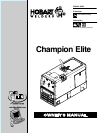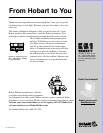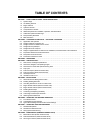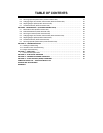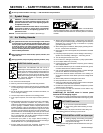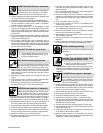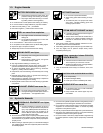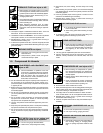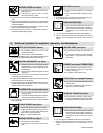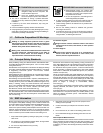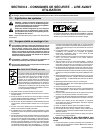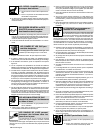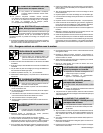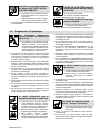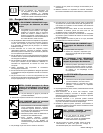
OM-240 438 Page 4
HYDRAULIC FLUID can injure or kill.
D Before working on hydraulic system, turn off and
lockout/tagout unit, release pressure, and be sure
hydraulic pressure cannot be accidentally applied.
D Relieve pressure before disconnecting or con-
necting hydraulic lines.
D Check hydraulic system components and all con-
nections and hoses for damage, leaks, and wear
before operating unit.
D Wear protective equipment such as safety
glasses, leather gloves, heavy shirt and trousers,
high shoes, and a cap when working on hydraulic
system.
D Use a piece of paper or cardboard to search for leaks−−never use
bare hands. Do not use equipment if leaks are found.
D HYDRAULIC FLUID is FLAMMABLE−−do not work on hydraulics
near sparks or flames; do not smoke near hydraulic fluid.
D Reinstall doors, panels, covers, or guards when servicing is
finished and before starting unit.
D If ANY fluid is injected into the skin, it must be surgically removed
within a few hours by a doctor familiar with this type of injury or gan-
grene may result.
MOVING PARTS can injure.
D Keep away from moving parts such as fans,
belts and rotors.
D Keep all doors, panels, covers, and guards
closed and securely in place.
D Keep hands, hair, loose clothing, and tools away from moving
parts.
D Before working on hydraulic system, turn off and lockout/tagout
unit, release pressure, and be sure hydraulic pressure cannot be
accidentally applied.
D Have only qualified people remove guards or covers for maint-
enance and troubleshooting as necessary.
D Reinstall doors, panels, covers, or guards when servicing is
finished and before starting engine.
HOT PARTS AND FLUID can burn.
D Do not touch hot parts bare handed or allow hot
fluid to contact skin.
D Allow cooling period before working on equip-
ment.
D To handle hot parts, use proper tools and/or wear heavy, insu-
lated welding gloves and clothing to prevent burns.
READ INSTRUCTIONS.
D Read and follow all labels and the Owner’s
Manual carefully before installing, operating, or
servicing unit. Read the safety information at
the beginning of the manual and in each
section.
D Use only genuine replacement parts from the manufacturer.
D Perform maintenance and service according to the Owner’s
Manuals, industry standards, and national, state, and local
codes.
1-5. Compressed Air Hazards
COMPRESSED AIR EQUIPMENT can
injure or kill.
D Incorrect installation or operation of this unit
could result in equipment failure and personal
injury. Only qualified persons should install, op-
erate, and service this unit according to its
Owner’s Manual, industry standards, and na-
tional, state, and local codes.
D Do not exceed the rated output or capacity of the compressor or
any equipment in the compressed air system. Design com-
pressed air system so failure of any component will not put people
or property at risk.
D Before working on compressed air system, turn off and lockout/
tagout unit, release pressure, and be sure air pressure cannot be
accidentally applied.
D Do not work on compressed air system with unit running unless
you are a qualified person and following the manufacturer’s in-
structions.
D Do not modify or alter compressor or manufacturer-supplied
equipment. Do not disconnect, disable, or override any safety
equipment in the compressed air system.
D Use only components and accessories approved by the manu-
facturer.
D Keep away from potential pinch points or crush points created by
equipment connected to the compressed air system.
D Do not work under or around any equipment that is supported
only by air pressure. Properly support equipment by mechanical
means.
HOT METAL from air arc cutting and
gouging can cause fire or explosion.
D Do not cut or gouge near flammables.
D Watch for fire; keep extinguisher nearby.
COMPRESSED AIR can injure or kill.
D Before working on compressed air system,
turn off and lockout/tagout unit, release pres-
sure, and be sure air pressure cannot be acci-
dentally applied.
D Relieve pressure before disconnecting or con-
necting air lines.
D Check compressed air system components
and all connections and hoses for damage,
leaks, and wear before operating unit.
D Do not direct air stream toward self or others.
D Wear protective equipment such as safety glasses, hearing pro-
tection, leather gloves, heavy shirt and trousers, high shoes, and
a cap when working on compressed air system.
D Use soapy water or an ultrasonic detector to search for leaks−−
never use bare hands. Do not use equipment if leaks are found.
D Reinstall doors, panels, covers, or guards when servicing is
finished and before starting unit.
D If ANY air is injected into the skin or body seek medical help im-
mediately.
BREATHING COMPRESSED AIR can in-
jure or kill.
D Do not use compressed air for breathing.
D Use only for cutting, gouging, and tools.
TRAPPED AIR PRESSURE AND WHIPPING
HOSES can injure.
D Release air pressure from tools and system be-
fore servicing, adding or changing attach-
ments, or opening compressor oil drain or oil fill
cap.



